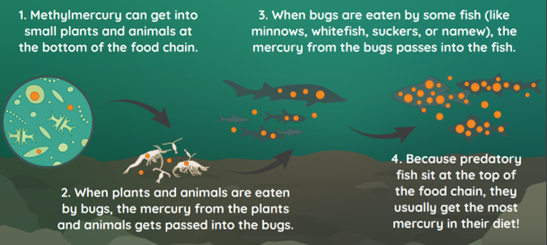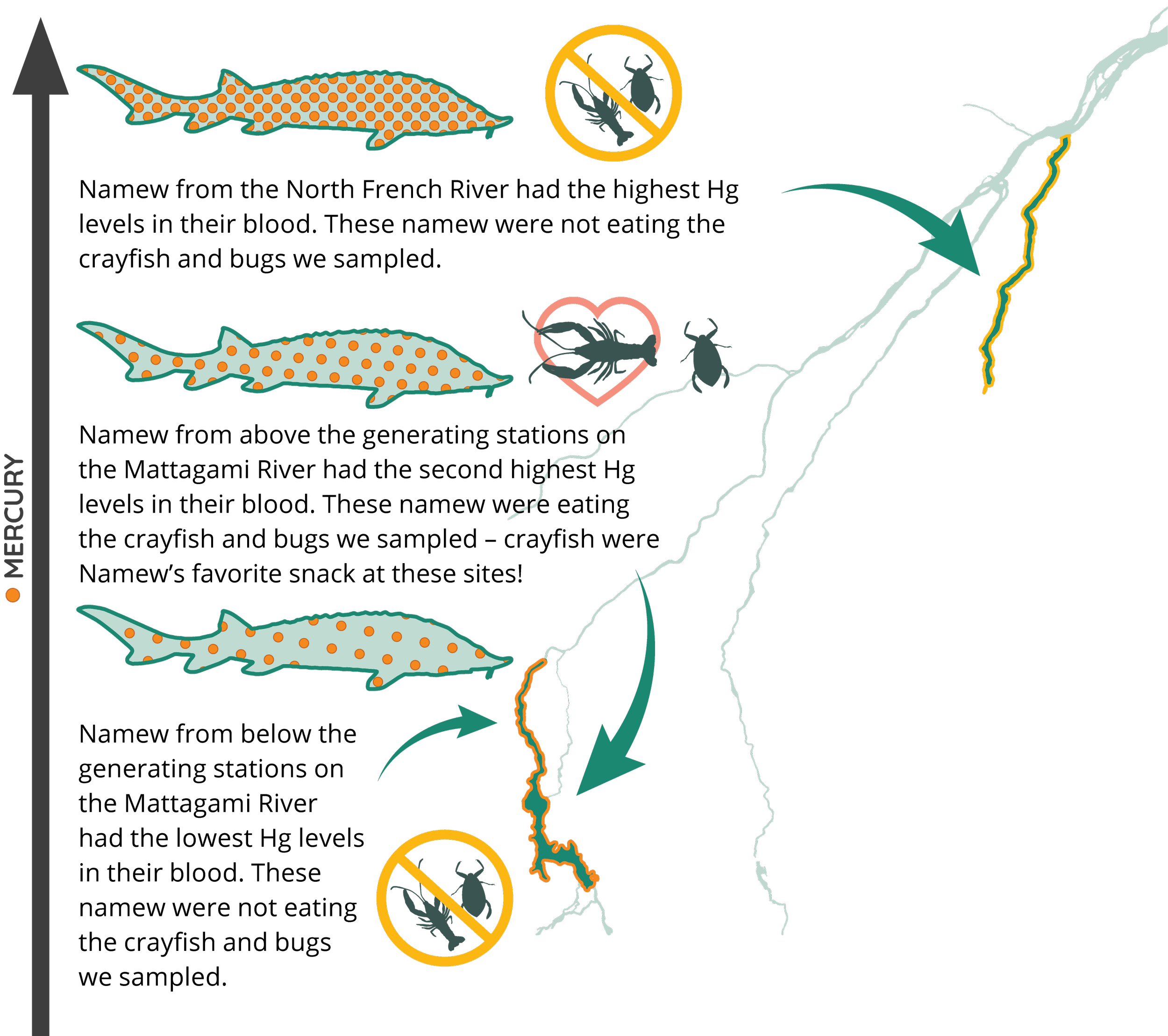In Case You Missed It: Research Paper Published!
We measured mercury in blood from namew in the Lower Mattagami and North French Rivers. We found the good news that mercury was fairly low in all namew blood samples – and we also found some interesting differences between the sites in what the namew are eating.
Our team published a scientific paper last year looking at levels of mercury and methylmercury in blood samples namew from above and below the Lower Mattagami Hydroelectric Complex, and in the North French River. We wanted to know, are levels of blood mercury and methylmercury higher in namew from around the Lower Mattagami Hydroelectric Complex than in namew from the North French River? Read on to learn what we found!
First, why did we want to look at blood mercury and methylmercury in namew? It is because mercury is a pollutant that can be found in fish all across the world. That’s because mercury can travel far and build up in the environment. Mercury can get into our atmosphere from far away sources, like coal-fire burning plants or small-scale gold mines. Mercury can come from natural sources too, like volcanoes!
If mercury washes into a lake or river, it can be changed into a harmful type of mercury called methylmercury by tiny bacteria.
Methylmercury enters the aquatic ecosystem at the base of the food chain and accumulates as it moves up, making top predators the most affected.
Hydroelectric facilities can increase mercury in fish too. When some hydroelectric facilities are built, they create a reservoir, like the one above the Little Long Generating Station on the Lower Mattagami River. Once flood, any mercury that had built up on the landscape is now in the reservoir where it can be changed into methylmercury by bacteria.
Reservoir construction can cause a surge in mercury levels in fish, with concentrations taking decades to return to pre-construction levels.
And why look at mercury and methylmercury in blood? Taking a little blood with a needle means that we could release the fish alive. We wanted to harm the namew as little as possible. Plus, mercury in blood can tell us a lot about the recent impact of the hydroelectric dams. Mercury in flesh shows how much mercury a fish has picked up over many years. But mercury in blood only shows the mercury a fish has recently picked up over the past few weeks, so it can help us understand if the hydroelectric dams are increasing mercury levels in namew right now.
Mercury exposure in fish can be tracked through blood for short-term changes and flesh for long-term accumulation.
We found the good news that mercury and methylmercury were fairly low in all namew blood samples relative to the benchmarks we looked at. Mercury levels were similar to sturgeon from other parts of Canada. Since the Little Long reservoir was built in 1963, it’s about 60 years old. If mercury levels spiked, they have probably dropped down again.
One interesting thing that we found, though, was that although the hydroelectric facilities aren’t raising mercury levels in namew’s blood, the hydroelectric facilities do seem to be changing what namew eats!
Like people, fish collect most of their mercury through their diet. So, figuring out what namew eats helps us understand their mercury levels too. Namew are usually bottom feeders, slurping up bugs and other things along the riverbed. So, we also sampled different kinds of bugs and crayfish from the Lower Mattagami and North French Rivers, and did some analyses and math using the different types of nutrients found in the bugs, crayfish, and from small samples of namew fin tissue to try to understand what namew are eating.
Mercury moves through aquatic ecosystems, affecting different fish species based on their diet and habitat.
We need to do more work in the North French River and below the hydroelectric facilities on the Mattagami River to find out what namew are eating. They may be eating different types of bugs or small fish and their eggs.
We also did not find many bugs downstream of the hydroelectric facilities, probably because the water levels are so variable. When the water level changes a lot, it’s harder for the bugs to make their homes and make more bugs!
We will keep studying the bugs and the water and try to learn more about these beautiful rivers and how they may affect namew’s home and diet.
Read the full paper open-access here!





